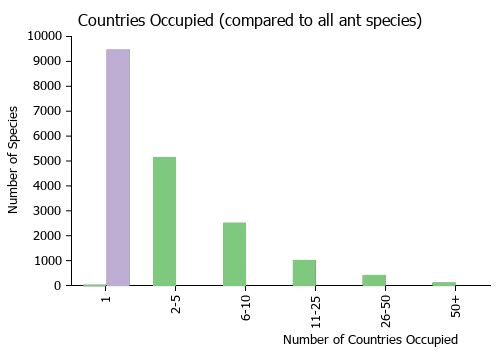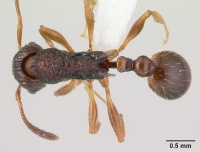Vitsika obscura
| Vitsika obscura | |
|---|---|

| |
| Scientific classification | |
| Kingdom: | Animalia |
| Phylum: | Arthropoda |
| Class: | Insecta |
| Order: | Hymenoptera |
| Family: | Formicidae |
| Subfamily: | Myrmicinae |
| Tribe: | Crematogastrini |
| Genus: | Vitsika |
| Species: | V. obscura |
| Binomial name | |
| Vitsika obscura Bolton & Fisher, 2014 | |
V. obscura has been found in a litter sample and by beating low vegetation.
Identification
Bolton and Fisher (2014) - This species is described as separate from Vitsika miranda with some reservations. Only four specimens of obscura are known, but they are consistently larger and lighter in colour than miranda, and have fewer but more widely spaced longitudinal costulae on the mesopleuron. Both miranda and obscura are similar to the yellow Vitsika astuta, but in that species some of the suberect setae on the dorsal (outer) surface of the metatibia are long and fine, at least as long as the maximum tibial width. In miranda and obscura all suberect setae on the dorsal (outer) metatibial surface are distinctly shorter than the width of the metatibia, and have a uniform, stubbly appearance.
Keys including this Species
Distribution
Endemic to Madagascar.
Latitudinal Distribution Pattern
Latitudinal Range: -22.12° to -22.12°.
| North Temperate |
North Subtropical |
Tropical | South Subtropical |
South Temperate |
- Source: AntMaps
Distribution based on Regional Taxon Lists
Malagasy Region: Madagascar (type locality).
Distribution based on AntMaps
Distribution based on AntWeb specimens
Check data from AntWeb
Countries Occupied
| Number of countries occupied by this species based on AntWiki Regional Taxon Lists. In general, fewer countries occupied indicates a narrower range, while more countries indicates a more widespread species. |

|
Estimated Abundance
| Relative abundance based on number of AntMaps records per species (this species within the purple bar). Fewer records (to the left) indicates a less abundant/encountered species while more records (to the right) indicates more abundant/encountered species. |

|
Biology
Castes
Known only from the worker caste.
Images from AntWeb
   
| |
| Holotype of Vitsika obscura. Worker. Specimen code casent0192019. Photographer Michele Esposito, uploaded by California Academy of Sciences. | Owned by CAS, San Francisco, CA, USA. |
Nomenclature
The following information is derived from Barry Bolton's Online Catalogue of the Ants of the World.
- obscura. Vitsika obscura Bolton & Fisher, 2014: 87, figs. 108-110, Map 158 (w.) MADAGASCAR.
Unless otherwise noted the text for the remainder of this section is reported from the publication that includes the original description.
Description
Worker
(holotype in parentheses). TL 4.1 (4.1), HL 0.91–0.92 (0.91), HW 0.75–0.78 (0.75), CI 82–85 (82), SL 0.68–0.69 (0.69), SI 88–92 (92), PW 0.59–0.61 (0.59), WL 1.20–1.22 (1.20) (4 measured).
Eye with 9 rows of ommatidia, and with 10–11 ommatidia in the longest row; EL 0.20–0.23 (EL/HW 0.27–0.29). MfL 0.86–0.88 (MfL/HW 1.11–1.16). Antennal scape yellow, distinctly lighter in shade than the brown head capsule. In profile, the dorsal outline of the propodeum with a short, horizontal plateau immediately behind the mesonotal-propodeal junction that then slopes down to the upper base of the propodeal spine, without a distinct peak in its outline posterior to the mesonotal-propodeal junction. Propodeal declivity with 3–4 distinct transverse costulae. Diameter of annulus of propodeal spiracle about equal to the thickness of the propodeal spine at its midlength. Petiole node in profile highest at the anterodorsal angle, the short dorsal surface grades imperceptably into the posterior face. In posterior view the dorsal margin of the petiole node evenly shallowly convex, or almost flat medially. Sculpture of petiole node weak to vestigial laterally; posterior surface of petiole node mostly smooth, but with some sculptural remnants immediately above the foramen. Height of petiole node in posterior view (from midpoint of the dorsal margin of the foramen to the apex) 0.78–0.92 × its maximum width. In dorsal view postpetiole 1.25–1.36 × broader than long; maximum width of postpetiole ca 0.95–1.06 × the length of a propodeal spine; maximum width of postpetiole 0.90–1.00 × the distance between the apices of the propodeal spines. Postpetiole node in profile relatively short and high, its dorsum distinctly convex; the length of the node in profile is visibly greater than the height of the segment. Dorsum of postpetiole node smooth. The main suberect setae on the dorsal (outer) surface of the metatibia are all about the same length, and distinctly shorter than the maximum tibial width. Full adult colour brown to dark brown.
Type Material
Holotype worker, Madagascar: 38 km. S Ambalavao [Prov. Fianarantsoa], Res. Andringitra, 22°12’S, 46°58’E, 1680 m., 23.x.1993, sifted litter (leaf mold, rotten wood), montane rainforest, BLF 820(10)-3, CASENT0192019 (B.L. Fisher) (California Academy of Sciences). Paratype. 1 worker with same data as holotype but BLF 820(16)-2, no CASENT number (CASC).
References
- Bolton, B. & Fisher, B.L. 2014. The Madagascan endemic myrmicine ants related to Eutetramorium (Hymenoptera: Formicidae): taxonomy of the genera Eutetramorium Emery, Malagidris nom. n., Myrmisaraka gen. n., Royidris gen. n., and Vitsika gen. n. Zootaxa 3791:1–99. doi:10.11646/zootaxa.3791.1.1

